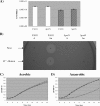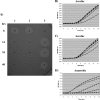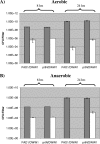Pseudomonas aeruginosa PAO1 pyocin production affects population dynamics within mixed-culture biofilms
- PMID: 19060137
- PMCID: PMC2631993
- DOI: 10.1128/JB.01458-08
Pseudomonas aeruginosa PAO1 pyocin production affects population dynamics within mixed-culture biofilms
Abstract
Transcriptomic and phenotypic studies showed that pyocins are produced in Pseudomonas aeruginosa PAO1 aerobic and anaerobic biofilms. Pyocin activity was found to be high in slow-growing anaerobic biofilms but transient in aerobic biofilms. Biofilm coculture of strain PAO1 and a pyocin-sensitive isolate showed that pyocin production had a significant impact on bacterial population dynamics, particularly under anaerobic conditions.
Figures




References
-
- Blázquez, J., J. M. Gomez-Gomez, A. Oliver, C. Juan, V. Kapur, and S. Martin. 2006. PBP3 inhibition elicits adaptive responses in Pseudomonas aeruginosa. Mol. Microbiol. 6284-99. - PubMed
Publication types
MeSH terms
Substances
LinkOut - more resources
Full Text Sources

